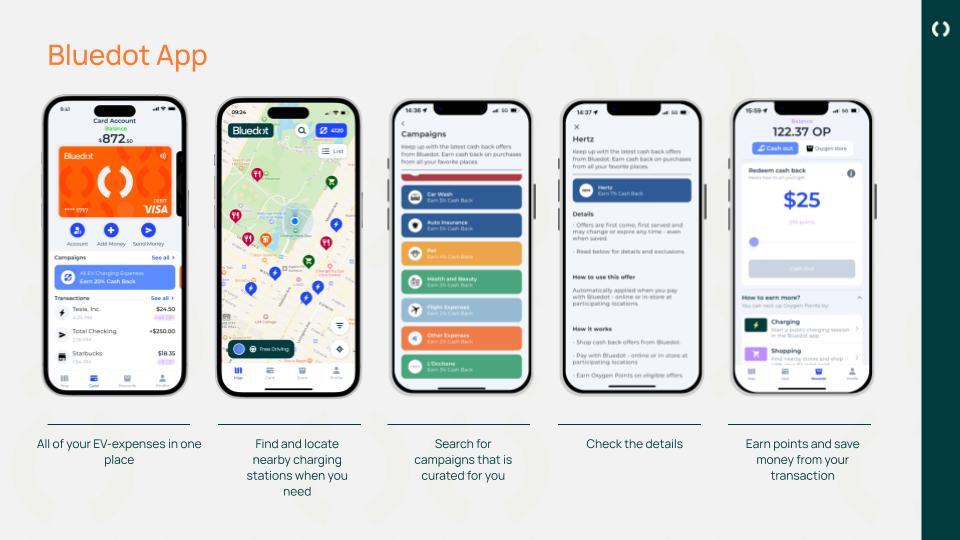Electric vehicles accounted for nearly 6% of all new cars sold in the U.S. in 2022, an increase from 3.1% the year before, and that number will continue to grow over the coming years. While it’s still a young industry, the ecosystem surrounding EVs — from EV charging and installation to insurance products and parking — is shaping up to be one that’s disconnected and somewhat complicated.
So say the founders of Bluedot, a banking and rewards platform for EV owners that aims to enhance the after-sales experience. Here’s how it works: Individual owners or fleet managers sign up for Bluedot’s debit card, which they’ll use for all auto-related purchases, but predominantly for EV charging. Bluedot is currently offering customers a flat fee of $0.30 per kilowatt hour of charging with participating EV charging stations, and 20% cash back on charges with nonparticipating charging networks. Customers find stations and pay directly for charges with partner charging companies on Bluedot’s app, saving them the need to download multiple apps.
Bluedot users also get 5% cash back on all automotive expenses, plus another 2% cash back for all other expenses. In addition, the company provides users with rewards in nearby shopping and dining locations. So while waiting for their car to charge, a customer can walk over to the local Starbucks for a coffee and get 10% cash back on that purchase, or do some shopping at Whole Foods and score another 15% cash back, for example.
The startup, which will join Y Combinator’s winter 2023 cohort and recently closed a $2 million pre-seed, is initially focusing on charging stations, in part because it’s an industry that’s about to blow up with federal and state funding. The Inflation Reduction Act, which President Joe Biden signed into law in August 2022, gives all states access to over $1.5 billion in funding to facilitate EV charging projects. That might end up looking like a big push to install infrastructure without much cohesion.

Bluedot’s app aggregates nearby EV charging stations and offers rewards for charging. Image Credits: Bluedot
Bluedot wouldn’t say which charging companies it works with to offer its flat fee, but the startup said customers could initiate charging through the Bluedot app at around 60% of all charging stations across the U.S. To grow its partner network, Bluedot is targeting smaller and newer charging companies that might not have the resources to create their own app and payments platform.
“New EV charging companies are seeking solutions like ours to increase visibility and accessibility for drivers, optimize payment processes, and improve utilization rate of charging stations,” Selinay Filiz Parlak, Bluedot’s co-founder and chief operating officer, told TechCrunch. “Bluedot is working on integrating financial technology to help these companies make their charging stations more viable and accessible to drivers.”
“Currently, utilization in most of the charging station networks ranges from 5% to 8%. Bluedot aims to raise this rate above 15%. We began with small charging station companies, but our goal is to bring all brands together with financial technology for users,” continued Parlak.
Bluedot’s main customers today are individual drivers who found the startup through partnerships with auto dealers and ride-share companies. Parlak says Bluedot’s next target is fleets to help them manage expenses and charging processes and get better deals.
“For example, one of our partners is a leasing company that rents cars out to a bunch of delivery drivers who are managed by a fleet manager,” said Parlak. “They want to offer a larger charging station ecosystem, which is easier to bill and then reimburse, which we offer. And they also want to get better deals around electrification.”
Bluedot is also manually pulling data for customers on their charging habits, how much they spend, how much power they use, their top charging locations, the amount of carbon dioxide emissions they’ve prevented by using an EV, and so on. In the future, the company wants to automate that task to make it smarter and more scalable.
During YC, Bluedot wants to focus on growth and product development.
“Our goal is to establish partnerships and make deals leading up to demo day,” Ferhat Babacan, Bluedot’s CEO and co-founder, told TechCrunch. “Specifically, we aim to secure partnerships in the areas of auto dealership, charging networks, and auto-related expenses. Additionally, we plan to initiate pilot tests for the Bluedot Fleet Card.”
Bluedot’s debit card for EV owners offers cheaper charging, cash back by Rebecca Bellan originally published on TechCrunch
from TechCrunch https://ift.tt/1Q9Gqkt
via IFTTT
Comments
Post a Comment